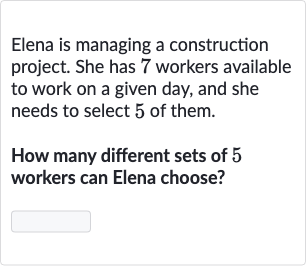Full solution
Q. Elena is managing a construction project. She has workers available to work on a given day, and she needs to select of them.How many different sets of workers can Elena choose?
- Identify problem type: Identify the type of problem. Elena is choosing workers out of without regard to the order in which they are chosen. This is a combination problem, not a permutation, because the order does not matter.
- Use combination formula: Use the combination formula to calculate the number of different sets. The number of ways to choose items from a set of items is given by the combination formula , where denotes factorial.
- Apply combination formula: Apply the combination formula to the given numbers. Elena has workers and needs to choose , so we need to calculate .
- Simplify factorials: Simplify the factorials in the formula. Calculate , , and .
- Cancel common terms: Cancel out the common terms in the numerator and the denominator. has in it, so we can cancel from both the numerator and the denominator. This leaves us with .
- Perform calculation: Perform the calculation. Calculate .
- Conclude with final answer: Conclude with the final answer. Elena can choose different sets of workers from the available workers.
More problems from Counting principle
QuestionGet tutor help
QuestionGet tutor help
QuestionGet tutor help
QuestionGet tutor help
QuestionGet tutor help
QuestionGet tutor help
QuestionGet tutor help
QuestionGet tutor help
QuestionGet tutor help

